After reading my copy of Superior Spider-Man #29 I’m reminded of that scene in Empire Strikes Back where Han keeps telling Chewbacca to “punch it” but the Millennium Falcon fails to zoom into hyper-drive.
It’s not that I don’t like “Goblin Nation” – I’ve found the storyline to be perfectly acceptable so far, but I keep waiting for writer Dan Slott to “punch” this arc into another gear. For all of Superior #29’s various storylines and dangling participles that are being queued up by Slott for some semblance of a payoff over the next few weeks, I’m still caught by this overwhelming sense that there’s still one big *thing* missing from “Goblin Nation” that ties everything together in a way that makes the last 16 months of my comic book reading life “worth it.” I still believe, at its core, any kind of storytelling, whether it be via a comic book, a movie or television, needs to take me on a journey. And all worthwhile journeys have a destination.
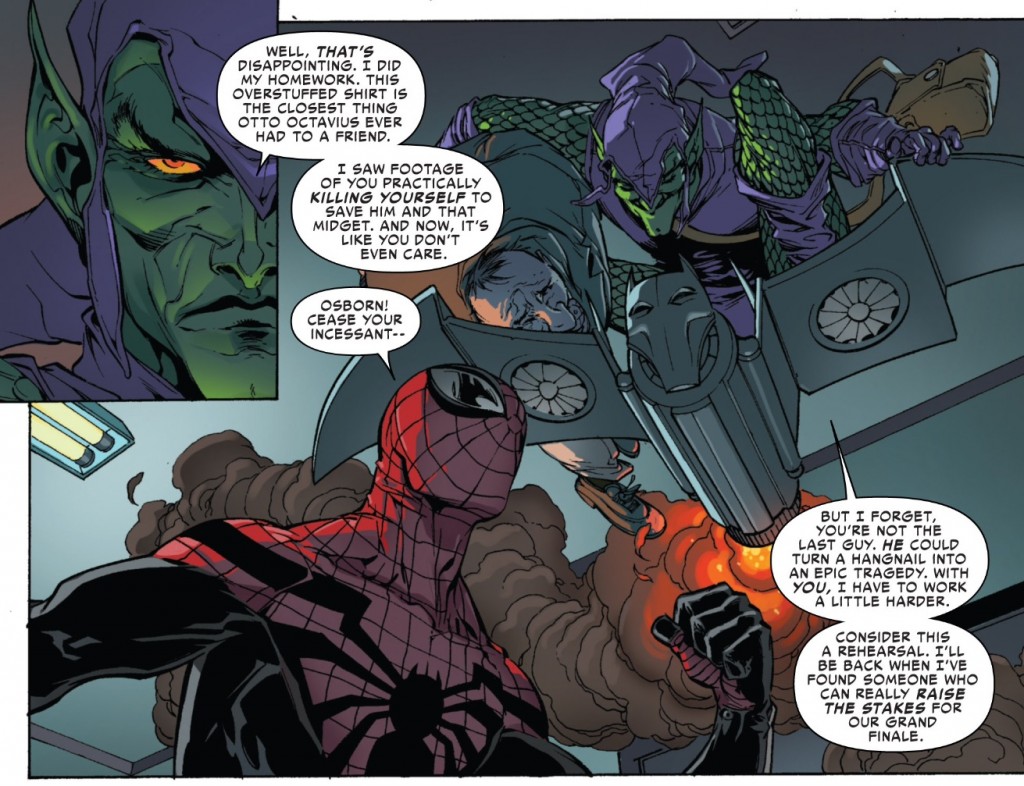 While there are still two issues (and another annual) left to change my mind about this, I recently came to the realization that when it comes time to deliver a proper post-mortem about the “Superior” era of Spider-Man, the one thing that will stand out to me above anything else is that for all of Slott’s ambition and risk-taking, he continues to struggle with the pacing and efficiency of his storytelling. In almost every issue of Superior – including the ones I have heaped a tremendous amount of praise on – there is always at least one or two scenes where I’m saying to myself, “why are things moving so quickly” while simultaneously hitting upon a moment that makes me go, “haven’t we traced over this ground already?”
While there are still two issues (and another annual) left to change my mind about this, I recently came to the realization that when it comes time to deliver a proper post-mortem about the “Superior” era of Spider-Man, the one thing that will stand out to me above anything else is that for all of Slott’s ambition and risk-taking, he continues to struggle with the pacing and efficiency of his storytelling. In almost every issue of Superior – including the ones I have heaped a tremendous amount of praise on – there is always at least one or two scenes where I’m saying to myself, “why are things moving so quickly” while simultaneously hitting upon a moment that makes me go, “haven’t we traced over this ground already?”
Having things moving too quickly and too slowly concurrently is a recipe for a frustrating reading experience, where I end up spending more time focusing on what’s wrong with the script than what’s right. In Superior #29, there’s a fantastic two page spread of the Green Goblin taunting Spider Ock by blowing up all of these random buildings and settings from Otto’s childhood. The Goblin’s actions manage to take this already boiling-over blood feud to a whole other level of hatred. And Slott verbally conveys this one sequence in very meta-fashion where the Goblin is basically tearing down Otto for being a “second” rate villain in the Spider-Man hierarchy.
But because of the haphazard pacing of this story, rather than just sit back and smile at the beauty that is the Green Goblin’s insidiousness, I start thinking of some other questions: if the Green Goblin has set his sights to just tormenting Otto now, why didn’t he do all this the moment after Spider Ock declined his offer to be “partners?” Why are the Goblins still screwing with Peter Parker and his friends and family? Why does the Green Goblin still seem to care who is underneath the Spider-Man mask (and while we’re at it, how does he communicate in to Parker Industries’ video technology, ask for Spider-Man but not know that “Peter” is Spidey)? What does the Goblin intend to do with Anna Maria besides put the idea in people’s heads that’s she’s just going to end up like Gwen Stacy before this is all over?
There’s even something ever so slightly awkward about the comics big reveal: Norman Osborn takes control of J. Jonah Jameson’s Spider Slayer army, essentially confirming his role as either the Green Goblin, or the overall criminal mastermind of “Goblin Nation” (I’m still not ready to concede that Norman is unquestionably the Goblin until we see his facein that costume). Either way, Norman’s physical involvement in this story should feel like a bigger moment, but there’s been so much misdirection and game playing about the Osborn family over the past year, that I don’t even know what to accept at face value anymore. Mysteries and cliffhangers are great, but did Slott overplay his hand in the preceding issues that it diminished the perceived importance of an otherwise landmark reveal for this series?
I’m sure if I asked Slott these questions directly he would tell me he can’t go into detail because it would spoil his story – which very well may be true. But I’m also under the impression that sometimes these storylines are just being flung out there in rapid succession in order to prevent readers from thinking too long and hard about a narrative that is possibly teetering at the top of a house of cards. Or in more crass terms: “blind them with bullshit.”
Then there’s the situation involving Astral Peter inside the “memory-scape.” As much as I love the way Giuseppe Camuncoli keeps delivering wondrous two page spreads depicting some of the finer moments of Doc Ock’s history, from a narrative standpoint, we still haven’t progressed much with this story. Peter is stuck within Doc Ock’s mind. He thinks he’s Doc Ock. This is very concerning for people who think they’re going to get Peter back in April. Then again, between Marvel’s solicitations and promotions for future issues and Dan Slott’s recent wave of “mwa ha ha ha-ing” on Twitter, it’s looking increasingly likely that the end of Superior doesn’t necessarily mean that Otto’s brain or spirit are going anywhere.
The point remains that when Slott gives us moments like Superior #29’s Astral Peter sequence, it comes across more as a writer just dotting “i’s” and crossing off “t’s.” He’s checking back in with Peter, because he has to, even though nothing new or groundbreaking is being said or advanced. I love the pretty pictures, but at this stage of the game, every stinking panel of this series needs to be moving something forward, even if it’s just character. These net-zero scenes just don’t work for me anymore.
Meanwhile, other characters are saying and doing things I’ve seen and heard them do before. Mary Jane is taking abuse from Spider Ock and bristling about it, but not actually doing anything that demonstrates that she’s either concerned by Peter’s behavior (didn’t she say that things were “different” and everything was better at the end of “The Darkest Hours” arcs in January?) or truly ready to move on.
Miguel O’Hara is back as Spider-Man 2099 and comments again that there’s something “off” about the way Spider-Man has been acting. This was established in the original Spider-Man 2099 arc last year.
Aunt May is Aunt May and Jonah is still JJJ, though Slott at least gives readers a nice little moment for Glory Grant where she walks out on her boss due to his obsessive vendetta against Spider-Man. But in a universe where so much seems to be changing for the titular character and a regular old Spider-Man comic with Peter back in the saddle without any conditions or “catches” seems to be a longshot, it would be nice to see some new material be generated for Spidey’s supporting cast.
So there’s a lot happening, but how much progress have we actually made on this journey Slott first took us on last January? And maybe that’s my biggest fear of all: that there is no actual destination and that all of these wheels are going to keep spinning until there’s we hit the finish line in arbitrary fashion, rather than an organic one. I’m keeping the faith, but as long as the Millennium Falcon still isn’t punching it into hyper-drive, I’m growing increasingly impatient.
All images from Superior Spider-Man #29: Dan Slott, Giuseppe Camuncoli, John Dell & Antonio Fabela

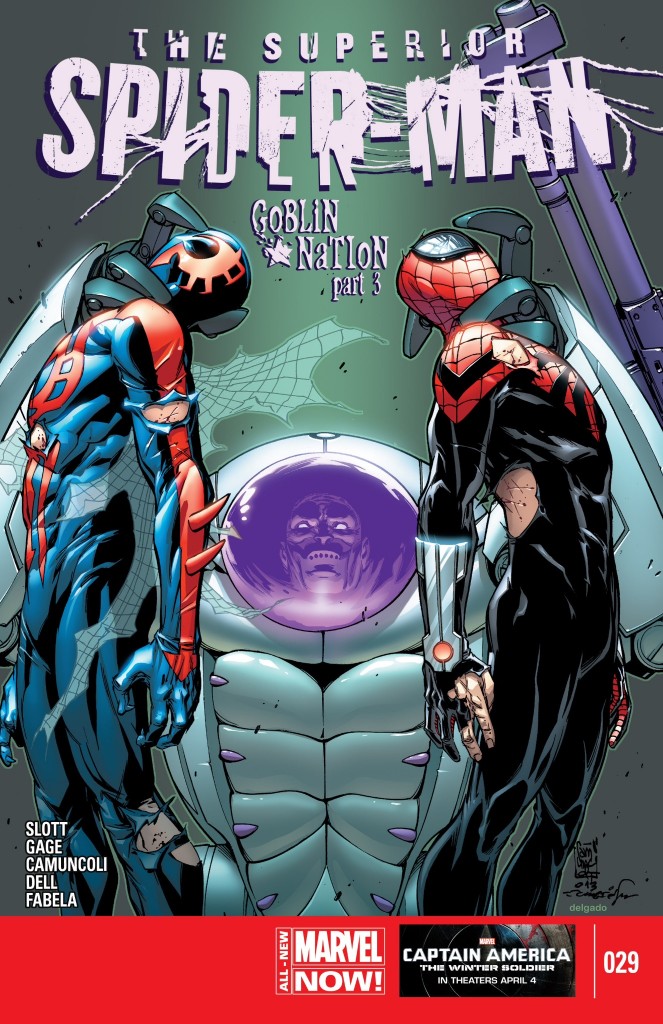
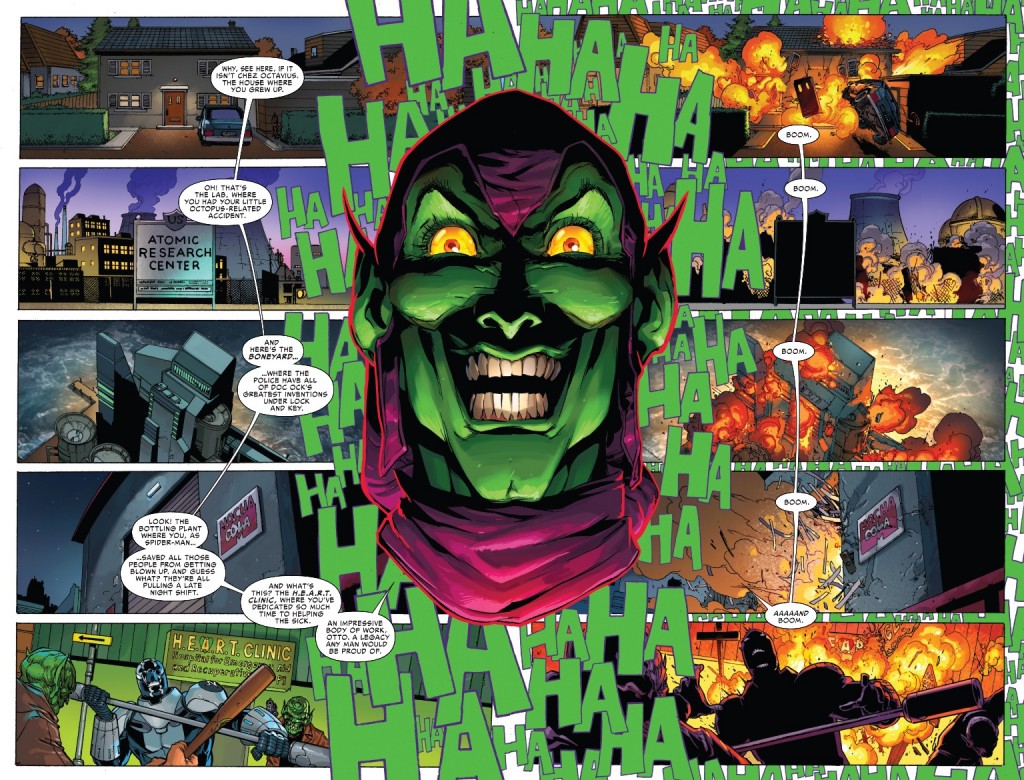
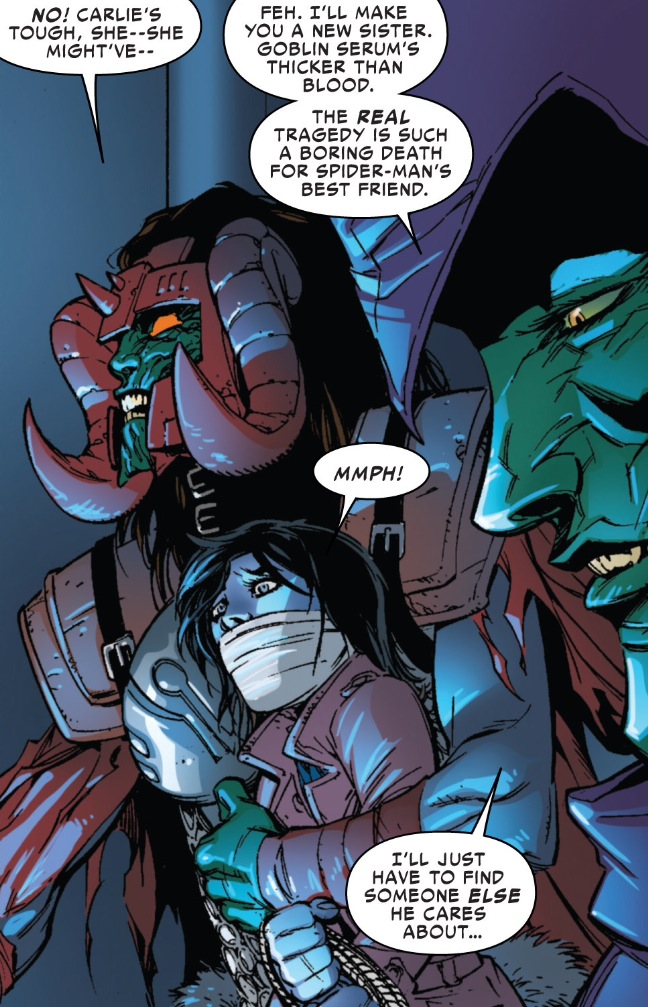
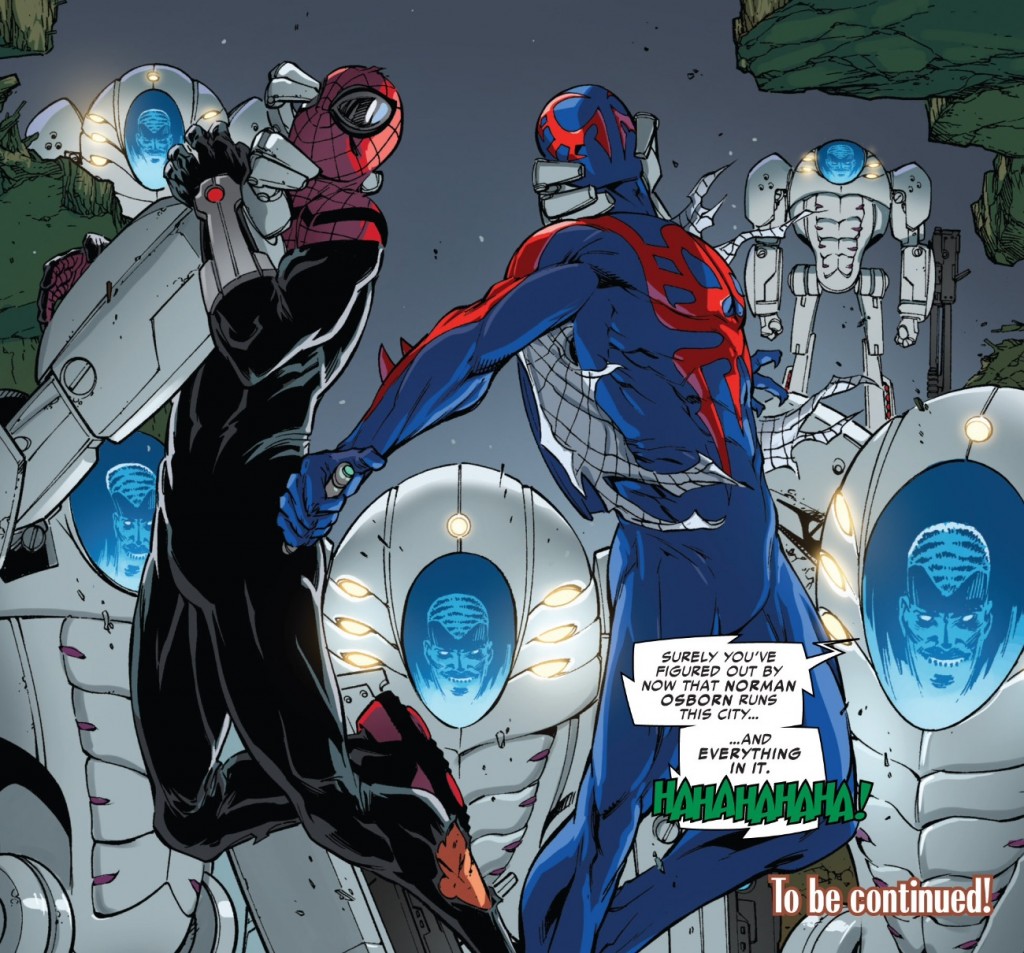
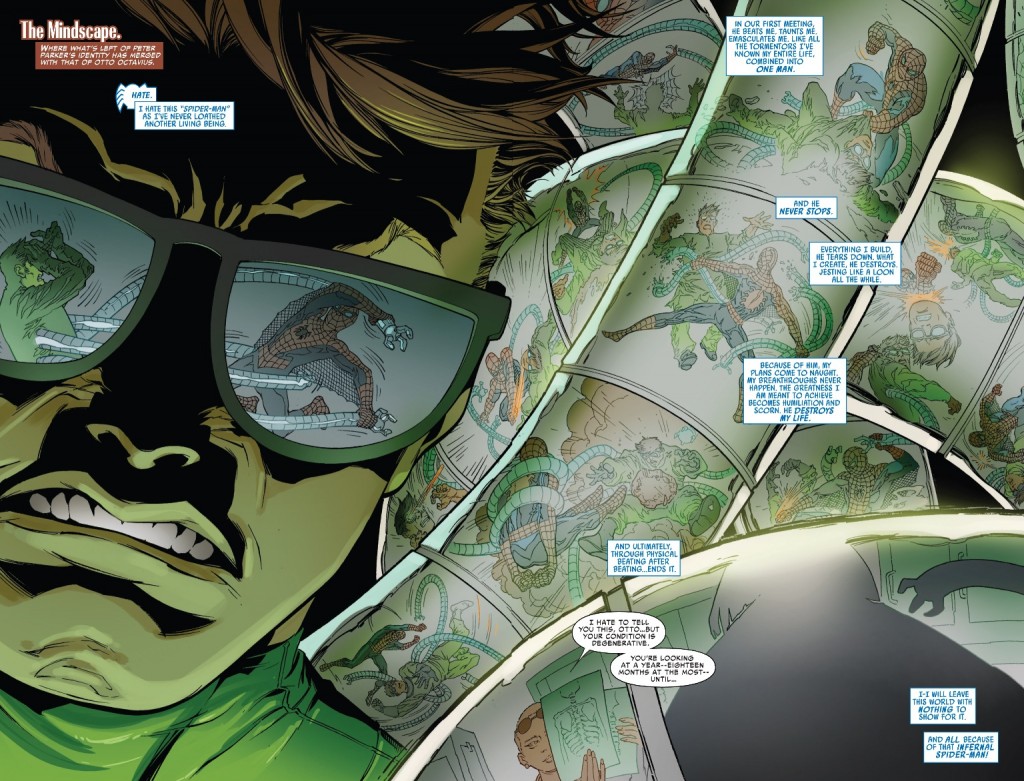
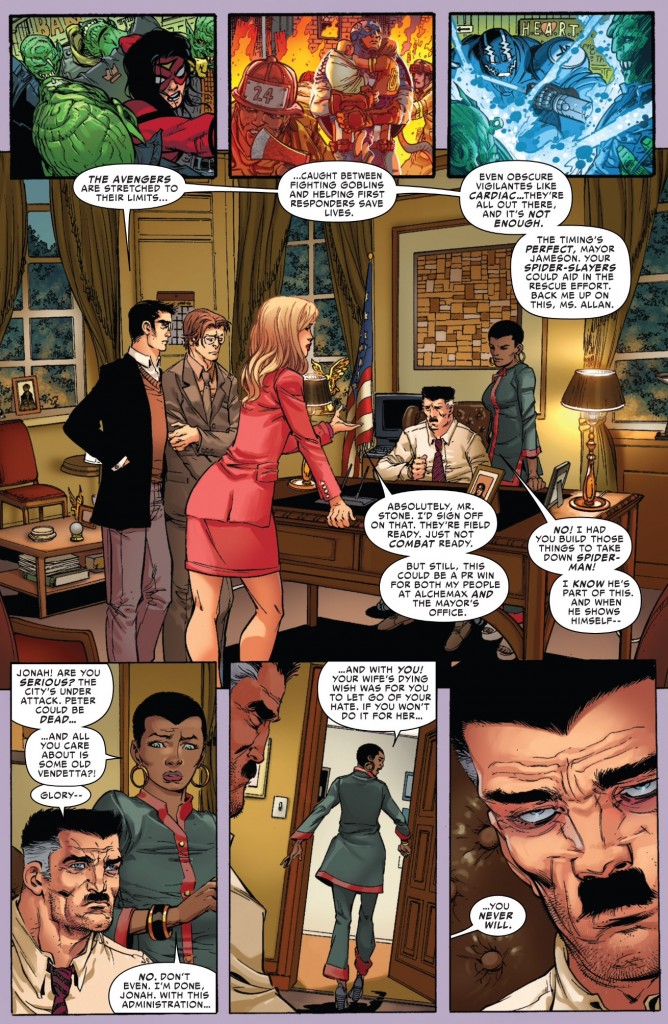

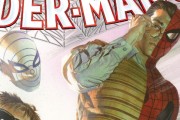
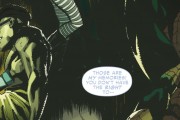
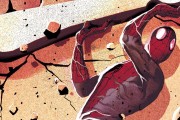
I enjoyed the issue, but did feel some oomph was missing. Osborn’s face on screen was not a huge moment for me. It left me feeling more like, “OK, more questions, what does this new element mean, ’cause it sure isn’t cut and dry.”
However, I read the mindscape sequence as quite significant. It’s setting something up that will be integral to Peter’s return. What new information do we learn? Previously, we saw Peter seem to blend with Otto’s psyche, changing him a bit. In this issue, we see this new blended-Peter progress through Ock’s memories towards the specific events of ASM 600, which was the first seed planted for this whole saga. I think these pieces of info were very deliberate. Certainly, the final image and final caption suggest to me that Peter is mixed up, but at least he now believes that he will have to defeat Spider-Man. The character has a goal now. I’m sure more elements will be added next issue, but I’m sure that SSM 29 was not just repeating a story beat from #28.
Norman’s second incarnation makes him seem so much like Lex Luthor, and I think the Goblin was always sort of modeled after the Joker (look at the grin, the eyebrows, and the backdrop of HA-HAs in that splash page — they’re not even hiding it anymore). It occurs to me that of Spider-Man’s greatest villains, Venom and Doctor Octopus are really the more original…although I always thought Doc Ock looked like a cross between Mole Man and Roy Orbison 😉
Yeah, Venom is truly more original …Just take the look of the hero , makes him look buffer, add some teeth , one tongue and here you go. Don’t forget to do the “evil twin” thing .. So ahead of its time !
Granted Ock, has a bit more of his own look , but Norman /Goblin is twice as charismatic than Otto , and his relation with Peter is more complex, so my choice is made .
One a side note , Norman played the”evil businessman” card way before Luthor started to do so . He screwed his associate over, and had contacts in the underworld without his Goblin persona , as seen in the “Amazing Spider-Man#37 and 38.
I do feel like some of the cutaways to the rest of the cast weren’t very consequential, and were probably in the issue more because Slott felt we needed to “check in” on them as opposed to because they necessarily moved the plot along. These pages would have been better served by developing Spidey 2099, who is still a bit of a blank slate in this series.
Even Peter, in the mindscape, didn’t do much; he’s come to understand Ock’s obsession with him, but this mental transition could have been done in last issue’s (much more impressive) entry into Ock’s memories.
Having said that, I thoroughly enjoyed and was engaged by the actual encounters between the Goblin and SpOck. The “boom-boom” sequence was great comics storytelling.